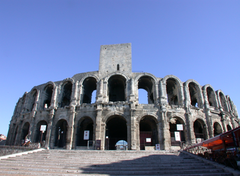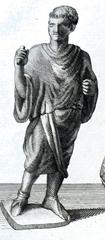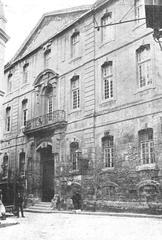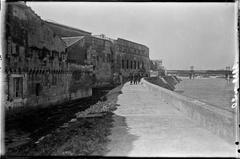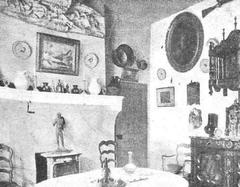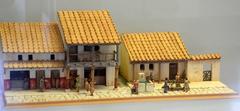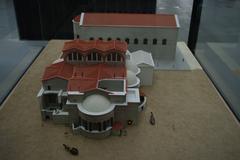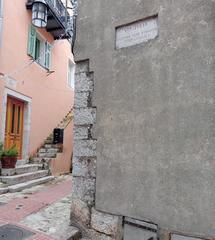
Montmajour Abbey Visiting Hours, Tickets & Historical Guide (Arles, France)
Date: 14/06/2025
Introduction
Montmajour Abbey, located just north of Arles in the heart of Provence, is a monumental testament to over a thousand years of religious, cultural, and architectural history. Perched atop a rocky outcrop with sweeping views of the Crau plain and Alpilles massif, the abbey invites visitors to explore a unique fusion of Romanesque, Gothic, and Classical architecture spanning eight centuries. From its origin as a prehistoric necropolis to its establishment as a Benedictine monastery in the 10th century, Montmajour Abbey has served as a spiritual sanctuary, a site of pilgrimage, and an inspiration for artists such as Vincent van Gogh. Today, it is a protected national monument and a vibrant cultural venue, recognized as a UNESCO World Heritage Site and a key location for the Rencontres d’Arles photography festival. This guide offers a comprehensive overview of Montmajour Abbey’s visiting hours, tickets, guided tours, accessibility, historical highlights, and practical tips to help you make the most of your visit (SpottingHistory; EuropeUpClose; Abbaye de Montmajour; Avignon-et-Provence).
Table of Contents
- Introduction
- Early Origins and Pre-Monastic Use
- Foundation and Monastic Development
- Pilgrimage and Relics: The True Cross
- Architectural Evolution: Key Highlights
- Prosperity, Decline, and Restoration
- Visiting Montmajour Abbey: Practical Information
- Visitor Experience: What to See
- FAQ
- Nearby Attractions & Suggested Itineraries
- Safety & Visitor Regulations
- Contact & Further Information
- Conclusion & Call to Action
- References
Early Origins and Pre-Monastic Use
Archaeological findings reveal that Montmajour was a sacred site long before the abbey’s foundation. As early as the 3rd millennium BCE, the rocky island—then surrounded by marshland—served as a cemetery, with tombs carved directly into the stone. These ancient sarcophagi, some shaped to fit the human body, testify to the site’s spiritual significance even prior to Christianity. During the 9th and 10th centuries, the island offered refuge from Saracen and Norman invasions, and local legends speak of St. Trophimus, the first bishop of Arles, seeking shelter here in the 1st century (SpottingHistory).
Foundation and Monastic Development
Montmajour’s recorded history as a monastic site began in 948 CE, when Teucinde of Arles, a local noblewoman, donated the island to a community of hermits, stipulating the creation of a Benedictine monastery. By 963, Pope Leo VIII recognized it as an abbey. The monastic community flourished under the support of local rulers, constructing the first church between 1030 and 1069, and expanding significantly during the Romanesque period (EuropeUpClose; Avignon-et-Provence).
Pilgrimage and Relics: The True Cross
Montmajour Abbey became a major pilgrimage destination in 1030 when it acquired a relic believed to be a fragment of the True Cross. This drew pilgrims from across the region, especially on the Feast of the Cross, when visiting the relic was said to absolve sins. The 12th-century Chapel of the Holy Cross, built specifically for pilgrims, stands outside the main monastic compound (EuropeUpClose; SpottingHistory).
Architectural Evolution: Key Highlights
Montmajour Abbey’s architecture reflects its continuous development:
- Romanesque Abbey Church (Notre Dame): The 12th-century church features a striking crypt, robust pillars, and a sober Romanesque style.
- Cloister: Restored in the 19th century, the cloister links the monastic buildings and is renowned for intricately carved capitals, including mythical creatures and biblical scenes.
- Hermitage of Saint-Pierre: The oldest part of the site, this troglodyte chapel carved into limestone dates to the 11th century.
- Chapel of the Holy Cross: Built for pilgrims, it showcases harmonious Romanesque proportions and a cross-shaped layout.
- Tower of Abbot Pons de l’Orme: Erected in the 14th century as a defensive structure, it offers panoramic views of the surrounding landscape.
- Maurist Monastery: The 18th-century addition introduces Classical style and reflects monastic life before the French Revolution (Abbaye de Montmajour; Avignon-et-Provence; nomads-travel-guide.com).
Prosperity, Decline, and Restoration
During the 12th and 13th centuries, Montmajour Abbey was one of Provence’s wealthiest monasteries, exercising control over vast lands. The 14th century brought hardship: the Black Plague, war, and repeated attacks forced construction of defensive structures. After a revival by the Benedictine congregation of Saint-Maur in the 17th century, the abbey was secularized and partially demolished during the French Revolution. Recognized as a historic monument in 1840, the abbey attracted artists like Vincent van Gogh and was later restored and opened to the public. Today, it is a UNESCO World Heritage Site and a dynamic venue for cultural events, including the Rencontres d’Arles (EuropeUpClose; Rencontres d’Arles).
Visiting Montmajour Abbey: Practical Information
Visiting Hours
- April – September: 10:00 AM – 6:30 PM
- October – March: 10:00 AM – 5:00 PM
- Last admission: 45 minutes before closing
- Closed: January 1, May 1, November 1, December 25
Check the official website for seasonal updates and special closures.
Tickets & Admission
- Adults: €8
- Reduced Rate: €6.50 (students, job seekers, large families, etc.)
- Free Admission: Children under 18 (EU residents), disabled visitors and their companions, and on the first Sunday of each month from November to March
Purchase tickets on-site; advance booking is recommended for groups (Abbaye de Montmajour).
Accessibility
Due to its historic structures, full accessibility is limited. Some ground-level areas are accessible with assistance, but the crypt, tower, and many upper levels require climbing stairs. Contact the abbey in advance for details (Abbaye de Montmajour).
Guided Tours & Events
- Self-guided visits: Free brochures in six languages are available at reception.
- Guided tours: Offered in French several times daily and included in admission. Registration is at the reception desk.
- Family and themed tours: Special programs for children (6–12 years) and themed workshops are available, especially during school holidays—with advance reservation recommended.
Travel Tips
- What to bring: Comfortable footwear, sun protection, water, and snacks (no on-site café).
- Best times: Early morning or weekdays for fewer crowds; spring and autumn for pleasant weather.
- Facilities: Free parking, restrooms, and a gift shop are available; no picnic areas or café on site.
Visitor Experience: What to See
- Begin at the Hermitage of Saint-Pierre, exploring its rock-cut chapel and monastic origins.
- Visit the Romanesque church and cloister, admired for sculpted capitals and tranquil atmosphere.
- Climb the Tower of Abbot Pons de l’Orme for panoramic views.
- Explore the Chapel of the Holy Cross and the evocative necropolis with ancient rock-cut tombs.
- Look for temporary exhibitions and art installations, especially during the Rencontres d’Arles.
- Photography is permitted throughout the site (no flash/tripods without prior authorization).
Frequently Asked Questions (FAQ)
What are Montmajour Abbey’s visiting hours?
10:00 AM – 6:30 PM (April–September); 10:00 AM – 5:00 PM (October–March). Last admission 45 minutes before closing. Closed Jan 1, May 1, Nov 1, Dec 25.
How much do tickets cost?
€8 for adults, €6.50 reduced rate. Free for children under 18 (EU), disabled visitors, and on the first Sunday of each month (Nov–Mar).
Are guided tours available?
Yes, several daily (in French), included in admission. Family and themed tours available with reservation.
Is Montmajour Abbey accessible for people with disabilities?
Some areas are accessible with assistance; many historic areas (crypt, tower) are not. Contact the abbey for details.
Can I visit by public transport?
Yes, bus line 702 links Arles and the abbey; cycling and taxis are also options.
Is photography allowed?
Yes, for personal use. Commercial photography and tripods require authorization.
Nearby Attractions & Suggested Itineraries
Montmajour Abbey is ideally combined with other Arles highlights such as the Roman amphitheater, Alyscamps necropolis, and the vibrant markets of Arles. Explore further into Provence with visits to the Roman ruins of Glanum, the villages of the Alpilles, and the Camargue regional park (charcotrip.com; france.fr).
Safety & Visitor Regulations
Expect bag checks as part of the French Vigipirate plan. Large backpacks, pets (except service animals), and tripods are restricted. For up-to-date safety information, consult the official site.
Contact & Further Information
- Website: Abbaye de Montmajour
- Phone: +33 (0)4 90 54 86 03
- Address: Route de Fontvieille, 13200 Arles, France
Conclusion & Call to Action
Montmajour Abbey stands as a crown jewel among Arles historical sites, offering visitors a captivating journey through centuries of faith, artistry, and Provençal landscape. By planning your visit around official opening hours and ticket options, you ensure a seamless and enriching experience. Enhance your exploration with the Audiala app for expert audio guides, and follow us on social media for the latest updates and travel inspiration. Dive into the heart of Provence at Montmajour Abbey—where history and beauty come alive.
References
- Montmajour Abbey: History, Visiting Hours, Tickets, and Guide to Arles’ Historic Gem, 2024, SpottingHistory (SpottingHistory)
- Montmajour Abbey: History, Visiting Hours, Tickets, and Guide to Arles’ Historic Gem, 2024, EuropeUpClose (EuropeUpClose)
- Montmajour Abbey: A Must-Visit Arles Historical Site with Visitor Information and Architectural Highlights, 2024, Abbaye de Montmajour Official Website (Abbaye de Montmajour)
- Montmajour Abbey: A Must-Visit Arles Historical Site with Visitor Information and Architectural Highlights, 2024, Avignon-et-Provence (Avignon-et-Provence)
- Montmajour Abbey Visiting Hours, Tickets, and Visitor Guide: Explore One of Arles’ Top Historical Sites, 2024, Arles Guide (arles-guide.com)
- Montmajour Abbey Visiting Hours, Tickets & Guide to Arles Historical Sites, 2025, Abbaye de Montmajour Official Website (Abbaye de Montmajour)
- Montmajour Abbey: History, Visiting Hours, Tickets, and Guide to Arles’ Historic Gem, 2024, Rencontres d’Arles Festival (Rencontres d’Arles)


